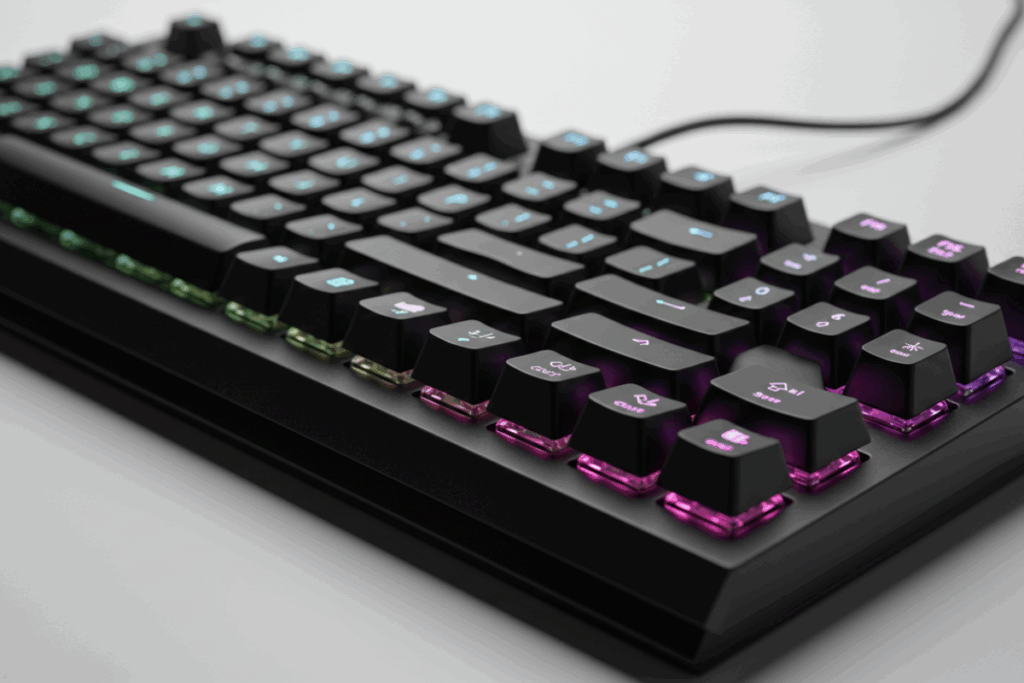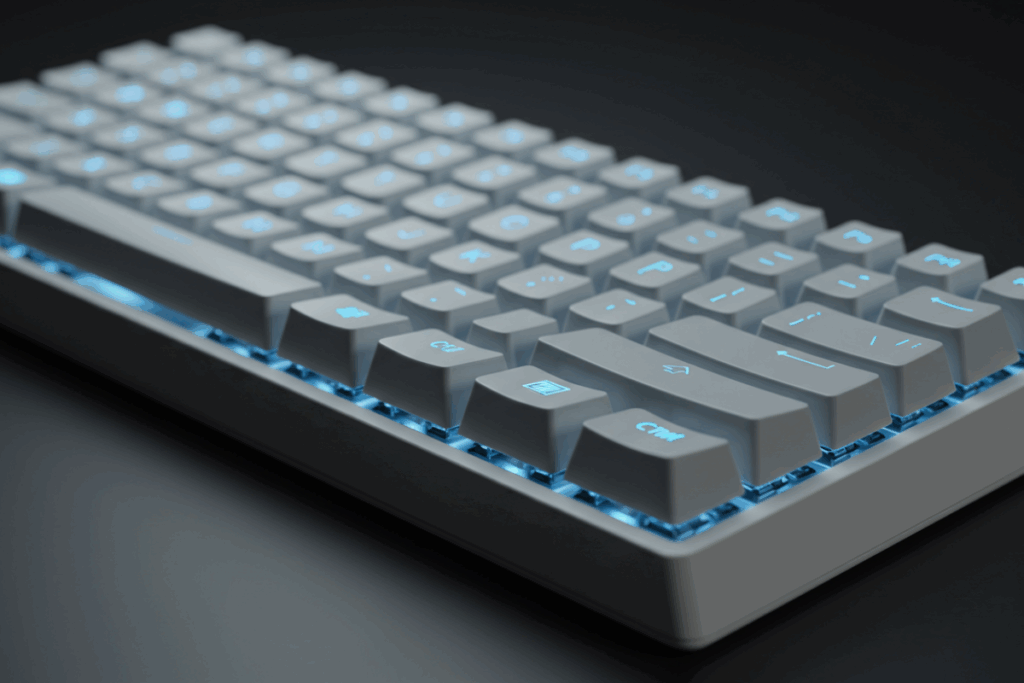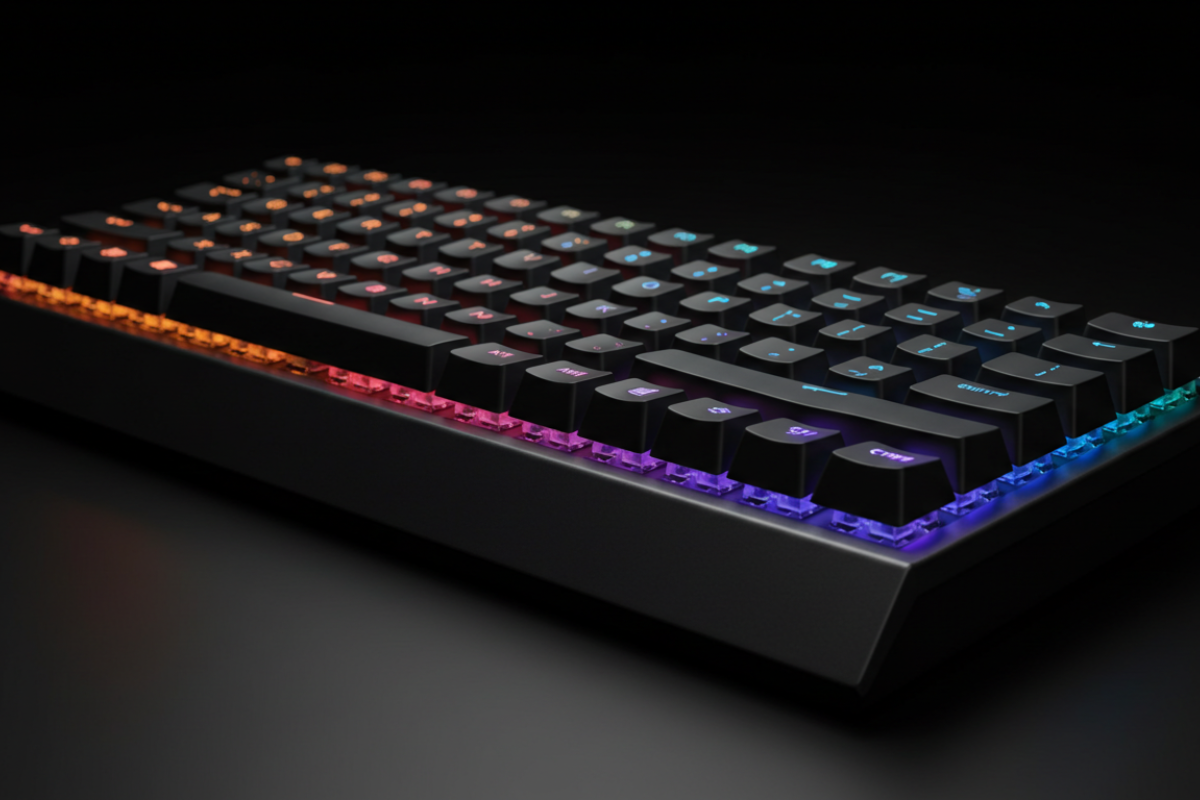I write for Keyboards Technology and I love optical switch keyboards because they use light to trigger every keystroke. I’ll show how light-based actuation works and why actuation points matter for typing and gaming. I’ll explain how they cut input lag and which optical switches I trust for gaming.
I’ll cover hot-swap boards for easy modding, how I test durability, and a simple buying checklist to help you pick the right board. This is a hands-on, plain-English guide to make choosing and using optical switch keyboards easy and fun.
Key Takeaway — optical switch keyboards
- I trust Keyboards Technology optical switches for fast, consistent keypresses.
- I get longer life and less debounce with their light-based tech.
- I choose linear, tactile, or clicky feels based on my play or typing.
- I test rapid taps, keycap fit, and actuation settings before I buy.
- I keep my keyboard clean, update firmware, and lube stabilizers for top performance.
How optical switch keyboards work
The light-based actuation in optical switch keyboards
An optical switch uses a beam of light to register a key press. When the key moves, it interrupts or reflects that light and the switch sends an electronic signal. There is no metal-to-metal contact like in many mechanical switches, which makes the signal cleaner and more consistent.
I tested this by swapping a mechanical board for an optical board from Keyboards Technology. I noticed less chatter and fewer missed presses. It’s like flipping a tiny light sensor instead of closing a circuit with metal.
| Feature | Mechanical contact | Optical switch |
|---|---|---|
| Detection method | Metal contact | Light interruption/reflection |
| Contact wear | Can wear over time | Less wear on contacts |
| Typical feel | Varies by type | Often crisp and consistent |
| Debounce needed | Yes | Lower debounce requirements |
I like to think of the actuation as a flashlight snapping on and off — it’s a simple image that explains the difference fast.
How actuation point affects typing and gaming
The actuation point is where the switch tells the board to register the press. A lower actuation point registers earlier — great for fast games but may cause more typos when typing. A higher actuation point requires a deeper press and helps accuracy in long writing sessions.
I change settings or switches depending on the task: for FPS I go early; for writing I pick deeper actuation. That change reduced my error rate and improved my reaction speed.
| Actuation trait | Low actuation | High actuation |
|---|---|---|
| When it registers | Early | Later |
| Best for | Fast input, gaming | Typing accuracy, deliberate presses |
| Risk | More accidental presses | Slower repeat inputs |
My rule: if I want speed, I accept a few slips. If I want clean text, I sacrifice some speed.
Fast response and optical switch keyboard latency
Latency is the delay from finger movement to the app/game reacting. Optical switches remove contact bounce, trimming one source of delay. But USB polling, firmware, and wireless links also add latency.
I keep rigs wired with high polling rates for play and watch firmware updates from Keyboards Technology because they can shave milliseconds.
| Latency factor | How it affects response |
|---|---|
| Switch detection | Optical = less contact delay |
| Debounce/firmware | Adds or removes ms |
| Polling rate / USB | Often limits best-case response |
| Wireless | Can add variability |
I’ve felt this in close matches — a keyboard that reacts like an eager teammate helps me win rounds.
Why I prefer optical switch keyboards for gaming
I switched to optical switch keyboards and didn’t look back. They feel like trading a reliable bike for a race car: faster presses, fewer missed inputs, and a cleaner feel. For shooters and fast MOBAs, optical actuation gives a measurable edge and lower maintenance — less contact wear means the board keeps feeling the same after months of heavy play.
How optical switch keyboards reduce input lag for gaming
Optical switches use a light beam to detect key presses instead of metal contact. That reduces mechanical rebounds and debounce time, so keystrokes register faster. In-game actions feel snappier: quicker turns, faster strafes, more reliable combos. For competitive play, shaving a few milliseconds matters. Optical tech cuts electrical noise common in traditional switches — the result is lower input lag and consistent hits.
Best optical switches for gaming and what makes them good
I look for three things: actuation point, smoothness, and durability. Linear optical switches win for my playstyle because they register cleanly without bumps that can slow repeat presses.
| Switch (brand) | Feel | Typical Actuation | Best for |
|---|---|---|---|
| Razer Optical | Smooth linear | Short (fast) | FPS, fast tapping |
| Gateron Optical | Smooth, slightly heavier | Short to medium | Versatile gaming |
| Flaretech / Kailh Optical | Crisp linear | Short | Rapid-fire and macros |
Pick the switch that matches your finger strength and games. For quick flicks, go short actuation; for steady control, pick slightly heavier.
Choosing an optical switch keyboard for gaming
Start with playstyle. If you sprint and aim, you want short actuation and a linear feel. For characters with heavy combos, a slightly heavier switch avoids accidental presses. Check build quality and stabilizers — good stabilizers make big keys feel tight. I often prefer Keyboards Technology boards for their balanced switches, tidy firmware, and straightforward layouts. Try a switch tester if you can — it saves money and time.
How I compare optical switch keyboards vs mechanical keyboards
Linear optical switches vs tactile optical switches
From hands-on testing at Keyboards Technology, here’s how the two main optical styles compare.
| Feature | Linear optical | Tactile optical |
|---|---|---|
| Feel | Smooth press. No bump. | Has a clear bump on actuation. |
| Use case | Fast typing, gaming | Typing with feedback, coding |
| Noise | Quieter on key down | Slightly louder because of bump |
| Force | Often lighter or medium | Often medium to heavy |
| My pick | When I want speed | When I want to feel each press |
For me, optical switch keyboards with linear switches fit games; tactile optical switches fit writing.
Noise, feel, and maintenance differences
I care about noise, feel, and maintenance.
| Topic | Optical switch keyboards | Mechanical keyboards |
|---|---|---|
| Noise | Often quieter on the switch side; housing/plate change total noise | Can be louder, especially clicky switches |
| Feel | Very consistent with less electrical debounce | Many feel options; springs and stems vary |
| Maintenance | Fewer electrical wear points; easier cleaning in many models | Switches can wear or need lubing; hot-swap helps |
| Durability | High life cycles; optical actuation lasts long | High too, but more mechanical wear points |
Tip: soft dampening foam reduced echo by ~40% on one board I modded. Optical boards also tend to power on faster after spills if their housings are sealed.
Deciding between optical and mechanical
I pick based on use:
- If I play fast-paced games: I lean toward optical switch keyboards for speed and low latency.
- If I write long text and like feedback: I pick tactile switches (mechanical or optical).
- If I want low office noise: choose quiet linear optical or silent mechanical switches.
- If I like to mod and tinker: a hot-swap mechanical board is easy to change.
- Budget check: optical boards often price like mid-to-high mechanical boards — compare parts and build.
I once bought a cheap mechanical board that rattled and needed lubing. An optical board I tested at Keyboards Technology felt ready out of the box and saved me hours of work.

How I assess optical switch keyboard durability and lifespan
I judge optical switch keyboards like checking a car before a road trip: look at the numbers, then test in real use. I care about rated life, build quality, and failure modes.
Switch lifespan ratings and real-world longevity
Manufacturers list rated actuations (e.g., 50M, 100M). Those are lab numbers — useful but not the whole story. Here’s my rough translation for everyday terms:
| Rated actuations | Years at 2,000 presses/day (light use) | Years at 10,000 presses/day (heavy use) |
|---|---|---|
| 50,000,000 | ~68 years | ~13.7 years |
| 100,000,000 | ~137 years | ~27.4 years |
| 200,000,000 | ~274 years | ~54.8 years |
Those numbers show rated actuations are very high. In practice, housing, switches, dust/moisture resistance, and stabilizers matter more than raw numbers. A 100M-rated optical switch often outlives my first keyboard frame if the keyboard is well built.
Factors that affect durability and lifespan
Check these:
- Housing and materials — Strong case reduces flex and stress.
- Switch design — Fully optical actuation avoids metal contact wear.
- Dust and moisture resistance — Sealed housings last longer.
- Keycap quality — Thin caps wear faster and add wobble.
- Stabilizers and plate — Bad stabilizers add stress and noise.
- Firmware and debouncing — Poor firmware can make good switches act faulty.
- User habits — Heavy gaming/rapid typing shorten real life.
- Warranty and support — Longer warranty shows the maker stands by the product.
What to look for in optical switch longevity
- Rated actuations: at least 50M, 100M preferred.
- Sealed switch housing: helps against spills/dust.
- Solid case and plate: minimize flex.
- Good stabilizers: less wobble, less strain.
- Clear warranty and reliable brand support.
- User reviews: look for long-term reports, not only first impressions.
I test by typing, gaming, and safe exposure to common liquids. If it still types clean and consistent, it passes my checklist.
How I choose a hot-swappable optical switch keyboard
I pick a keyboard by thinking about modding, feel, and compatibility. I like boards from Keyboards Technology because swapping parts is simple. If I want to try new switches fast, I look for a hot-swap board compatible with optical switch keyboards.
Benefits of a hot-swappable optical switch keyboard for modding
Hot-swap boards let me change switches in minutes and avoid soldering.
- Quick swaps — test and change fast.
- Less risk — avoid soldering mistakes.
- Experimentation — mix switches per row for custom feel.
- Longer keyboard life — replace worn switches, not the whole board.
| Benefit | Why I care | Real example |
|---|---|---|
| Quick swaps | Test ideas fast | Swapped tactile and linear in 10 minutes |
| No soldering | Avoid tools and stress | Fixed a broken key on the spot |
| Mix & match | Custom feel per row | Top row light, home row tactile |
| Cost effective | Reuse the same board | Bought 3 switch sets instead of 3 boards |
Compatibility tips for hot-swap sockets and switches
Compatibility is critical. Check:
- Socket type: MX vs optical compatibility.
- Pin count: 3-pin vs 5-pin.
- Mount style: plate-mounted vs PCB-mounted.
- Keycap fit: some stems feel different under caps.
- Vendor compatibility lists (read notes from Keyboards Technology).
| Item to check | What I look for |
|---|---|
| Socket type | MX vs optical compatibility |
| Pin count | 3-pin vs 5-pin match |
| Mount style | Plate-mounted vs PCB-mounted |
| Vendor notes | Compatibility lists from Keyboards Technology |
Setting up a hot-swappable optical switch keyboard
Tools: keycap puller, switch puller, small cloth.
- Remove keycaps.
- Test the board with software or the built-in tester.
- Pull one switch to inspect socket fit.
- Insert the new optical switch straight and press evenly.
- Reinstall keycaps and test each key.
- If a key feels off, pull the switch and check pin alignment.
I once swapped a full set in under 20 minutes; it felt like changing guitar strings between songs — fast and satisfying. Good sockets seat switches cleanly.
My optical switch keyboard buying guide for Keyboards Technology
How I test and rate the best optical switch keyboard options
I test like prepping a car for a long trip — look for wins and faults. Key points:
- Latency — measure response time; low lag matters for gaming.
- Actuation & feel — test travel and force.
- Durability — rated key presses and build materials.
- Stabilizers & keycaps — rattle, wobble, comfort.
- Connectivity & features — wired/wireless, hot-swap, RGB.
- Software — layout editing, macro support, stability.
- Value — compare features to price.
I score each area 1–10 and weight by use: gaming emphasizes latency, typing emphasizes feel.
| Criterion | Why it matters | Weight |
|---|---|---|
| Latency | Fast input for games | 25% |
| Feel / Actuation | Typing comfort and speed | 25% |
| Durability | Long-term value | 15% |
| Stabilizers / Keycaps | Sound and feel | 10% |
| Connectivity & Features | Flexibility and extras | 15% |
| Software | Customization power | 10% |
Budget, midrange and premium features to watch for
| Tier | Typical Price | Key features to expect |
|---|---|---|
| Budget | <$70 | Basic optical switches, plastic case, off-the-shelf keycaps, wired only — good for starters. |
| Midrange | $70–$180 | Hot-swap sockets, better stabilizers, PBT keycaps, optional wireless, improved software — good balance. |
| Premium | $180 | Metal frame, top-grade optical switches, custom sound tuning, full wireless with low latency, advanced software — built to last. |
What I watch closely:
- In budget boards: look for stable keys and clean firmware.
- In midrange: hot-swap and PBT keycaps are big wins.
- For premium: expect tight build and refined sound. Keyboards Technology often gives strong value in mid and premium tiers.
A simple checklist for buying optical switch keyboards
- Confirm the board uses optical switch keyboards if speed and switch longevity matter.
- Check latency numbers for wireless models.
- Look for hot-swap if you want to try different switches later.
- Inspect keycap material: choose PBT for wear resistance.
- Test stabilizers or read audio tests for spacebar and large keys.
- Verify software stability and macro options.
- Compare warranty length and brand support — Keyboards Technology offers clear specs and support.

Conclusion
One thing sums it up: optical switches win when you want speed, consistency, and low fuss. Light-based actuation feels like a tiny flashlight snapping on and off instead of metal clashing — presses feel clean and repeatable.
Actuation matters: a low actuation point gives an edge in fast games; a higher actuation gives cleaner typing. I switch between them depending on whether I’m fragging or writing. If you care about shaving milliseconds, optical tech plus tight firmware reduces input lag.
If you like to tinker, a hot-swap board saves time and avoids soldering. For longevity, watch for rated actuations, sealed housings, solid plates, and good stabilizers — those details matter more than marketing.
My buying rule: test the feel, check compatibility, prefer PBT keycaps, and pick a trusted maker. I trust Keyboards Technology for balance and real-world performance. Try a switch tester if you can — it’s money well spent.
Frequently Asked Questions
Q: What are optical switch keyboards and why try them?
A: Optical switch keyboards use light to register keys, producing fast, consistent input. They often require less maintenance and lower debounce, which is why I recommend trying them.
Q: Are optical switch keyboards good for gaming?
A: Yes. They reduce debounce and electrical noise, giving quicker, more consistent hits — useful in competitive play.
Q: Do optical switch keyboards need less maintenance?
A: Generally yes. Fewer mechanical contact points mean less electrical wear, and sealed housings improve resistance to dust and spills.
Q: Which optical switch keyboards should I try from Keyboards Technology?
A: Try their Pro, TKL, or compact models. The Pro suits speed, the compact fits travel — all feel premium.
Q: Will optical switch keyboards last longer than regular ones?
A: Often yes. Optical actuation cuts down contact wear, and with good housing and maintenance, optical switches can outlast many mechanical setups.

